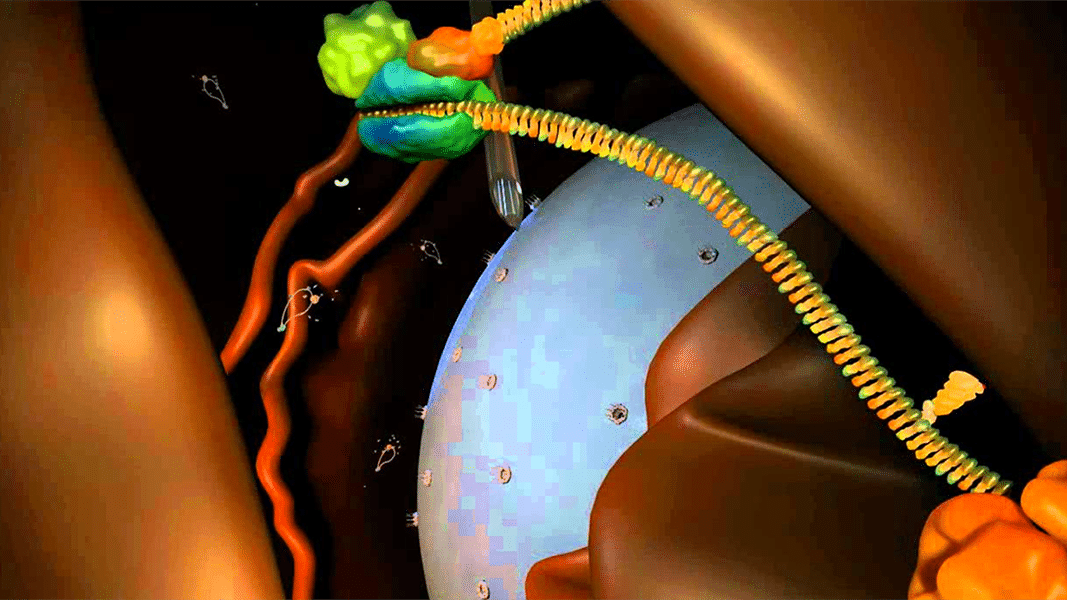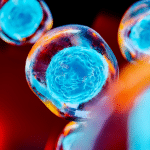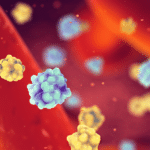There is growing interest among medical scientists in the gene-regulating properties of cannabidiol (CBD), the non-psychoactive plant cannabinoid. Researchers at the California Pacific Medical Center have shown that CBD reduces brain cancer and breast cancer cell proliferation and metastasis by inhibiting the expression of the ID-1 gene. ID-1 expression is implicated in several kinds of aggressive cancer.
In 2012, Israeli scientists identified more than 1,200 genes affected by CBD: Six hundred and eighty “gene transcripts” were upregulated (“turned on”) by cannabidiol and 524 were downregulated (“turned off”) by cannabidiol in a probe that focused on CBD’s role in zinc homeostasis. In the same experiment, THC was found to regulate 94 genes. “The results show that CBD, but much less so THC, affects the expression of genes involved in zinc homeostasis and suggest that the regulation of zinc levels could have an important role through which CBD may exert its anti-oxidant and anti-inflammatory effects,” the Israeli research team concluded.
How Does CBD Regulate Gene Expression?
It is well accepted among cannabinoid scientists that CBD has little binding affinity for either CB1 or CB2, the canonical cannabinoid receptors, both of which are activated by THC. Instead, cannabidiol works its magic primarily through receptor-independent channels and by binding with various non-cannabinoid receptors.
Recent studies indicate that CBD influences the expression of some genes by directly activating PPAR-gamma, a non-cannabinoid receptor situated on the cell’s nucleus. CBD’s ability to activate PPAR-gamma has promising therapeutic implications, particularly with respect to cancer and metabolic disorders.
What Are PPARs?
Peroxisome proliferator activated receptors (PPARs) are a group of three nuclear receptors—PPAR-alpha, PPAR-gamma, and PPAR-delta (the latter is not yet well-characterized). PPARs are triggered by hormones, endogenous fatty acids, and various nutritional compounds. When activated, PPARs bind to certain segments of DNA to promote or prevent transcription of specific genes.
Many of the genes regulated by PPARs are involved in energy homeostasis, lipid uptake and metabolism, insulin sensitivity, and other metabolic functions. Big Pharma recognizes the importance of these nuclear receptors. Thus far, two classes of pharmaceutical PPAR activators—fibrates and thiazolidinediones—have been approved by the U.S. Food and Drug Administration.
Anandamide (AEA), the endocannabinoid that activates the CB1 receptor, also binds to the PPAR-gamma nucleaer receptor. Anandamide is part of a family of endogenous fatty acid molecules, known as known as N-acylethanolamides, which includes N-palmitoylethanolamide (PEA) and N-oleoylethanolamide (OEA). PEA and OEA both activate the other nuclear receptor, PPAR-alpha.
Omega Threes & CBD
Nutritional factors also influence PPAR signaling. The omega-3 fatty acid derivatives docosahexaenoyl ethanolamine (DHEA) and eicosapentaenoyl ethanolamine (EPEA) directly activate PPAR-gamma. DHEA and EPEA can be created in the body from the fish oil constituents docosahexaenoic acid (DHA) and eicosapentaenoic acid (EPA).
At the 2013 International Cannabinoid Research Society conference in Vancouver, Jocelijn Meijerink from Wageningen University in the Netherlands reported that DHEA acts as an inhibitor of the COX-2 enzyme. So does CBD; this is one of the major reasons why cannabidiol has potent anti-inflammatory properties. COX-2 is an enzyme that creates prostaglandins, a class of inflammatory compounds. Asprin and all the other non-steroidal anti-inflammatory drugs are COX inhibitors.
Angiogenesis
According to a 2008 report by Italian scientists at the University of Rome, both PPAR-alpha and PPAR-gamma agonists regulate angiogenesis, which entails the creation of new blood vessels, particularly capillaries. In cancerous tumors, dysregulated angiogenesis leads to new blood vessels, which provide tumors with nutrients, helping them to grow and metastasize. By directly activating PPAR-gamma, CBD may inhibit tumor angiogenesis.
Three major complications associated with Diabetes Mellitus—retinopathy, neuropathy, and nephropathy—are all worsened by aberrant angiogenesis. Among medical scientists there is great interest in using PPAR agonists to prevent many diabetic complications. However, there is conflicting data regarding the effect of PPAR signaling on angiogenesis. Although numerous PPAR agonists have shown efficacy in preventing retinal angiogenesis, some studies report that activating PPARs can amplify angiogenesis. But the overall scientific consensus seems to be that PPAR-alpha and PPAR-gamma agonists prevent angiogenesis.
Clinical Applications
Obesity and metabolic syndrome. Most genes regulated by PPARs are involved with lipid metabolism and energy storage. PPAR activation typically promotes glycolysis (glucose breakdown), lipolysis (lipid breakdown), and insulin sensitivity, These properties make PPAR activation a promising treatment for type II diabetes and obesity. The PPAR-activating drugs fibrates and thiazolidinediones (PPAR-alpha agonists and PPAR-gamma agonists, respectively) have been approved to treat dyslipidemia (obesity) and insulin insensitivity in type II diabetics.
Cancer. PPAR-gamma activation has demonstrated an anti-proliferative effect as well as an ability to induce tumor regression in human lung cancer cell lines. But in some cases PPAR activation can also have an opposite result. In clinical trials, fibrates and thiazolidinediones, as well as some drugs that activate multiple PPARs, often have a side effect of increasing the risk of cancer. These contradictory findings need to be examined further.
Alzheimer’s. In 2011, an Italian research team reported that PPAR-gamma activation degrades amyloid-beta plaque, a key molecule in the development of Alzheimer’s disease. This is one of the reasons why cannabidiol, a PPAR-gamma agonist, may be a useful remedy for Alzheimer’s patients.
Schizophrenia. PPAR-alpha agonists in particular are indicated as an adjunct treatment for schizophrenia. Polymorphisms or mutations in the gene encoding PPAR-alpha are associated with schizophrenia. Furthermore, PPAR-alpha activation is both anti-inflammatory and can decrease dopamine release, thereby minimizing schizophrenic symptoms. This may help to explain how and why CBD has anti-psychotic effects.
Martin A. Lee is the director of Project CBD. He’s authored and edited several books, including Smoke Signals, Acid Dreams, and The Essential Guide to CBD. Adrian Devitt-Lee is a research scientist and longtime Project CBD contributor. © Copyright, Project CBD. May not be reprinted without permission.
Sources
- Ament Z, et al, “Applications of metabolomics for understanding the action of peroxisome proliferator-activated receptors (PPARs) in diabetes, obesity and cancer,” Genome Medicine,” 2012.
- Biscetti F, et al, “Peroxisome proliferator-activated receptors and angiogenesis,” Nutrition, Metabolism & Cardiovascular Diseases, 2009.
- Chearwae W and Bright JJ, “PPAR-gamma agonists inhibit growth and expansion of CD133+ brain tumour stem cells,” British Journal of Cancer, 2008.
- Costa M, et al, “Investigation of endocannabinoid system genes suggests association between peroxisome proliferator activator receptor-alpha gene (PPARA) and schizophrenia.,” European Psychopharmacology, 2012.
- Esposito G, et al, “Cannabidiol reduces amyloid beta-induced neuroinflammation and promotes hippocampal neurogenesis through PPAR-gamma involvement,” PLOS One, 2011.
- Juknat, A, et al, “Cannabidiol affects the expressions of genes involved in zinc homeostasis in BV-2 microglial cells,” Neurochemical International, 2011.
- Ramer R, et al. “COX-2 and PPAR-gamma confer cannabidiol-induced apoptosis of human lung cancer cells,” American Association for Cancer Research (AARC), 2012.
- Rovito D, et al, “Omega-3 PUFA ethanolamides DHEA and EPEA induce autophagy through PPARg activation in MCF-7 breast cancer cells,” Journal of Cellular Physiology, 2013.
- Song M, et al, “Modulation of diabetic retinopathy oathiohysiology by natural medicines through PPAR-g-related pharmacology,” British Journal of Pharmacology, 2012.
- Sugden M, et al, “PPAR control: it’s SIRTainly as easy as PCG,” Journal of Endocrinology, 2010.
- Treacy, MP and Hurst, TP, “The case for intraocular delivery of PPAR agonists in the treatment of diabetic retinopathy,” BMC Opthalmology, 2012.







